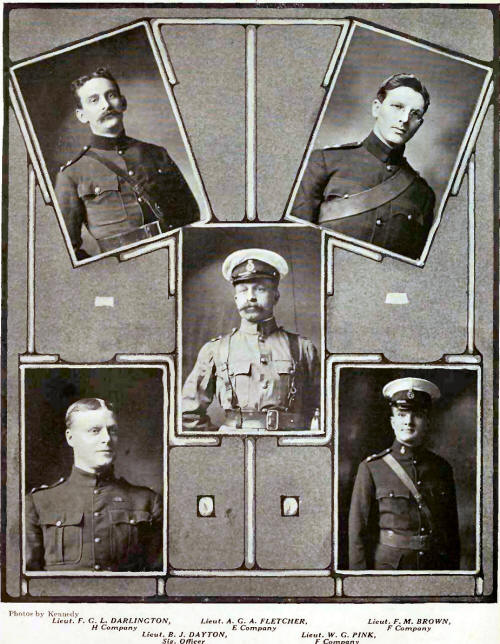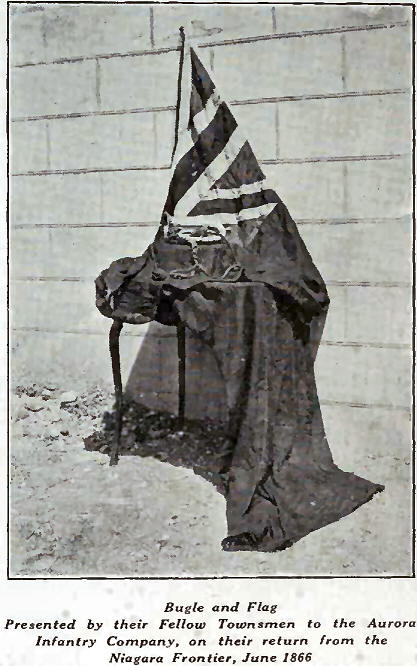|
The Welding of the
Battalions
THE troubles known as
the Fenian Raids, divested of their feeble pretense of freeing Ireland,
originated in the disbanding of the enormous armies of the Civil War.
For just as the unlucky contestants in any series of sports will clamor
for a “Consolation Race,” so after any period of warfare there are
ambitious and unsatisfied soldiers to whom peace appears in the garb of
a robber of their opportunities for achieving fortune and fame. Louis
Napoleon, having withdrawn from Mexico, there was only Canada to turn
to. Accordingly, Canada was in for it.
Two causes contributed towards the prosperous organization of a series
of raids into Canada. One was the immemorial dishonesty of American
governments in the matter of filibustering movements; which before the
authorities suppressed them must have been attempted, have failed and
palpably be incapable of future success. The other cause was that
treacherous torpidity in military matters which with the Canadian
precedes a sudden and venomous activity, a torpidity which induced the
incursions of 1812, 1838 and 1866.
However obliviously sdense the American Government could be towards the
organizing, enrolling and drilling of masses of armed Fenians in their
cities the Canadian authorities were not able to achieve such heights of
philosophy. Repeated alarms were met with sporadic preparations to
receive with the appropriate salute of ball cartridge an enemy who might
land at any time or place. Thus for four weary months from December
30th, 1804, two service companies of the Queen's Own patrolled the
Niagara Frontier.
Again in November, 1865, the city regiments picketted the drill shed in
Toronto, and companies were sent to Sarnia where ultimately a
provisional battalion was formed.
In March, 1866, the militia were called out and among those who left for
the front to be stationed at Port Colborne, were six companies from the
5th Military District, of which two companies were the Aurora Infantry
Company and the Scarboro Rifles.

Finally it became
evident a few days previously to May 31st, that some movement was in
progress in the American towns and cities along the Niagara frontier,
and by the night of the 31st it was manifest that a mobilization was in
progress for an immediate descent on the Canadian shore. The actual
landing took place at 3.30 the following day, but late in the night of
the 31st the call to arms was telegraphed from Ottawa, and within an
hour the sound of bugles and alarm bells was heard echoing and ringing
in nearly every town and village in the country.
The response of the militia to the bugles and the orders calling them
out was, as always is the case with the Canadian militia, instantaneous.
The impression one gets from reading of how few hours were required to
get the men together is that they were already straining at the leash.
The news of their required mobilization arriving in the evening, the
Queen’s Own were at their armoury at 4.30 in the morning and embarked at
7 a.m. for Port Dalhousie. As fast as transportation was provided the
other forces were carried to the scene of hostilities. The Northern
Railway arrived at Toronto at 10.40 a.m. on June 2nd, bearing among
others the Aurora Infantry Company, the King Infantry Company, under
Capt. Garden and the Scarboro Rifles, and by the afternoon train came
the Lloydtown Companv along with the Collingwood Rifles.
When we, at this distance of time, contemplate the strategy of General
Napier, who commanded in Canada West and of Col. Peacocke, who was
entrusted with the command of the troops in the Niagara Peninsula, we
feel that it is a tribute to the inherent loyalty of the Canadians that
they did not for all time lose faith in the soundness of British
generalship.
With the vaguest possible information as to the movements of the Fenians
after their landing at Fort Erie, it did not occur to General Napier to
mobilize any mounted troops until June 2nd, after the despatch of the
Queen’s Own and other foot soldiers to Port Colborne and St. Catherines.
It is safe to say that if either Col. Peacocke or Lieut.-Col. Booker had
with him on June 1st even a troop of cavalry and it had displayed some
of the energy shown two days later by Geo. T. Denison,4 with his troop
of Governor-General’s Body Guard, the column under Booker would not have
received the snubbing it got at Ridgeway and the Fenians would not have
escaped from pursuit. To add to the difficulties of Peacocke the
authorities had posted the Queen's Own, the 13th and the York and
Caledonia Companies under Booker at Port Colborne, which is a villainous
distance from St. Catherines, whence Peacocke set out and also from
Cliippewa to which he pushed on. If it was the strategical intention to
unite these columns, the utility of so widely separating them the day
before is one of those mysteries that make the art of war so profound a
study. At any rate Peacocke attempted to effect a junction with Booker
at Stevensville. Whatever chance this most delicate of all
operations,—the junction of widely separated columns within striking
distance of the enemy,—might have had was destroyed by the slowness of
Peacocke’s own march and the erratic conduct of Capt. Akers (Peacocke’s
officer sent to advise Booker), and Lieut.-Col. Stoughton Dennis, who
carried off some of the troops from Port Colborne to conduct an attack
on the Fenians at Fort Erie. This attack on Fort Erie which was to cover
these officers with glory earned them a smart beating and is just
another illustration of that greatest of all nuisances among military
officers, the half-baked tactician who, regardless of his superior’s
plans, attempts to carry off the “kudos” for himself.
The combat at RidgeAvay has often been described. The man most
vociferously abused at the time, Lieut.-Col. Booker, appears in reality
both before and after the one mistake he made to have acted with good
military sense and courageous coolness. In this mistake of forming a
square on the alarm of “cavalry ” he was simply the victim of a
formation in the drill book. And be it noted that the formation was
until a year ago still there, lying ambushed in the sections relating to
Savage Warfare; waiting for the day when some too literal minded British
officer should form a hollow square in close formation against the wrong
savages.

Ridgeway over and the
Fenians having escaped, the various companies and battalions performed
outpost duties at different places for a period of about three weeks
when they were relieved of duty and thanked in a general order of June
23rd, by the Commander-in-chief, who took occasion also to advise them
to continue their drill and discipline as the danger of invasion was not
past.
Among the numerous deficiencies of our militia system6 the authorities
proceeded to remedy two pressing defects. One was that the liability to
be called out repeatedly on alarms was beginning to harass the militia.
For the postprandial patriot who waves the old flag in an ecstasy of
Britannic zeal and then permanently fills his employee’s position when
he has gone to the front was more in evidence in 1855 than he would
venture to be in these days.
The other defect was the lack of cohesion among the numerous independent
companies whose officers and men had no conception of carrying out
anything like a combined movement.
Both these defects could be met by forming a standing camp where the
companies could be welded into battalions and at which by taking a
week’s tour of duty in rotation each group of militia would get some
military experience without being unsettled in their civil employments.
The ground selected for this camp was on the high level overlooking St.
Catherines, the Great Western Railway and the Welland Canal to the
westward of Thorold village. The first volunteer troops posted were the
16th from Toronto and the 7th from London. With them were a portion of
the 16th Regulars and of the Royal Artillery, also Major Denison and his
troop of cavalry. They assembled on the 18th of August, and on the 26th
the 10th and 7th were relieved by the Q.O.R. the 13th and the 22nd
Oxford Rifles.
The turn of the companies in which we are more particularly interested
came in the middle of September. That they made a good impression on
their way to the mill we learn by the following extract from a Toronto
daily:
“Military: Five, companies of infantry arrived in town by special train
on the Northern Railway on Saturday, as follows: Bradford, Lieut. Wilson
commanding; Aurora, Major Peel; Newmarket, Capt. Boultbee; King, Capt.
Garden and Lloydtown, Capt. Armstrong. The Scarboro Rifles under Capt.
Taylor, got on the Grand Trunk train at Scarboro Station, and arrived
about an hour earlier. They departed together with Brigade Major Dennis
on the steamer City of Toronto, at noon for the camp at Thorold to
relieve the volunteers now serving there. A more soldierly looking set
of men could not well be got together. Col. Durie, Brigade Major
Denison, Col. R. S. Denison and several other principal officers
together with a large number of citizens were on the wharf to witness
their departure.”
In the same issue of the paper appears this item:
“12th York Battalion Infantry: Headquarters at Aurora. To be
Lieut.-Colonel—Capt. D. Jarvis from the 2nd Battalion Queen’s Own
Rifles, Toronto.” The tour of duty being completed the battalion was
relieved by the Brant and Haldimand Battalions and returned to Toronto
under its first commanding officer whose pride was no doubt greatly
enhanced by subsequently receiving the following letter:
“Sir I have the honour to request you will make known to the officers
and men of the 12th (York) Battalion my extreme gratification at the
fine and soldier like appearance and demeanour of the Battalion on
Monday 22nd instant, of which I shall have the pleasure of making a
special report to H. E. the Commander-in-Chief.
“The proficiency of this young Battalion in Drill and the steadiness of
the men is very creditable to you as commanding officer.”
I have the honor to be, Sir,
Your very obedient servant,
J. S. Macdonald, Col. W.G. Lt.-Col,. Jarvis, Commanding 12th York,
Newmarket. |
